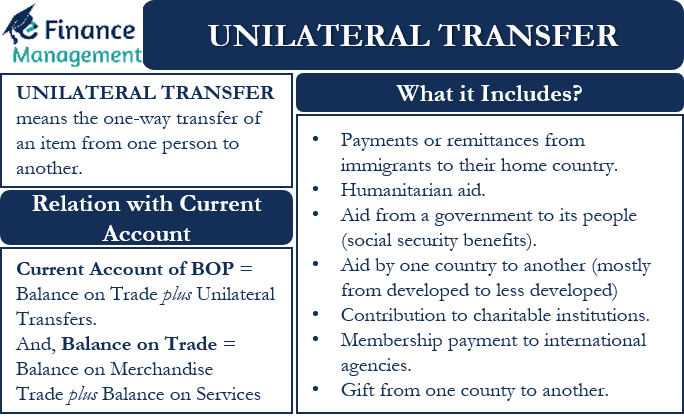Unilateral Transfer means the one-way transfer of an item from one person to another. Such one-way transfers are without any expectations of anything in return. However, this term is commonly used when talking about the Balance of Payment (BOP). Instead, we can say that it is an important component of the Balance of Payment. And primarily the part of the Current Account.
In terms of BOP, such transfers include the payment from a government to the people and the payment of aid by one nation to another. It also includes subscription payments to international agencies and funds to charitable institutions. For instance, stimulus checks by the U.S. government to the people at the time of the coronavirus pandemic are a type of Unilateral Transfer.
We can say that in the case of such transfers, the sender does not get anything in return. That is why these are called one-way transfers. One must not confuse these transfers with a bilateral transfers. In a bilateral transfer, both parties get monetary items in return.
Unilateral Transfer – What it Includes?
Unilateral Transfers include the following items:
- Payments or remittances from immigrants to their home country.
- Humanitarian aid.
- Payment or aid from a government to its people, such as social security benefits.
- Aid by one country to another. Usually, the aid is from developed or prosperous nations to less-developed nations.
- Contribution to charitable institutions.
- Membership payment to international agencies.
- Gift from one county to another. This gift could be from a person, business or government.
A point to note is that unilateral transfers could be of money or assets. Many experts argue that direct aid to a country may have unintended negative consequences. For instance, a corrupt government may use the aid for other purposes, such as for acquiring weapons, bolstering their military power, and more. However, we are here trying to understand the concept. Utilization of these aids (and their impact is not part of this article) and is the pre-rogative of the Governments, NGOs, and people who receive them.
Also Read: Current Account Balance of Payments

Relation with Current Account
Unilateral transfers represent those items and gifts from foreign countries and entities that are recorded in the current account of a Country’s Balance of Payments. In other words, it is part of a BOP. However, these transfers do not come in the computation of the balance of trade, despite the fact that the balance on trade, transactions relating to goods and services, is also part of the current account of the BOP.
So, the Current Account of BOP = Balance on Trade plus Unilateral Transfers.
And, Balance on Trade = Balance on Merchandise Trade plus Balance on Services.
In the current account, the receipt of unilateral transfers comes on the credit side, while the outflow of such transfers is shown on the debit side.
Other names for Unilateral Transfers are One-sided Transactions or Unrequited Transfers. There is also Net Unilateral Transfer. It is the balance of the Unilateral Transfer account. Or the difference between all the Unilateral Transfers that a country receives and the transfers that a country makes.
The U.S. has had negative net transfers since World War II except in 1991. In 1991, the U.S. got transfers from many nations for the Persian Gulf War. Otherwise, being a rich, developed, and leading nation of the world, the US always gives grants and aid to the poor and other nations.

